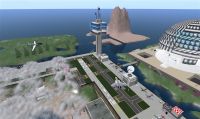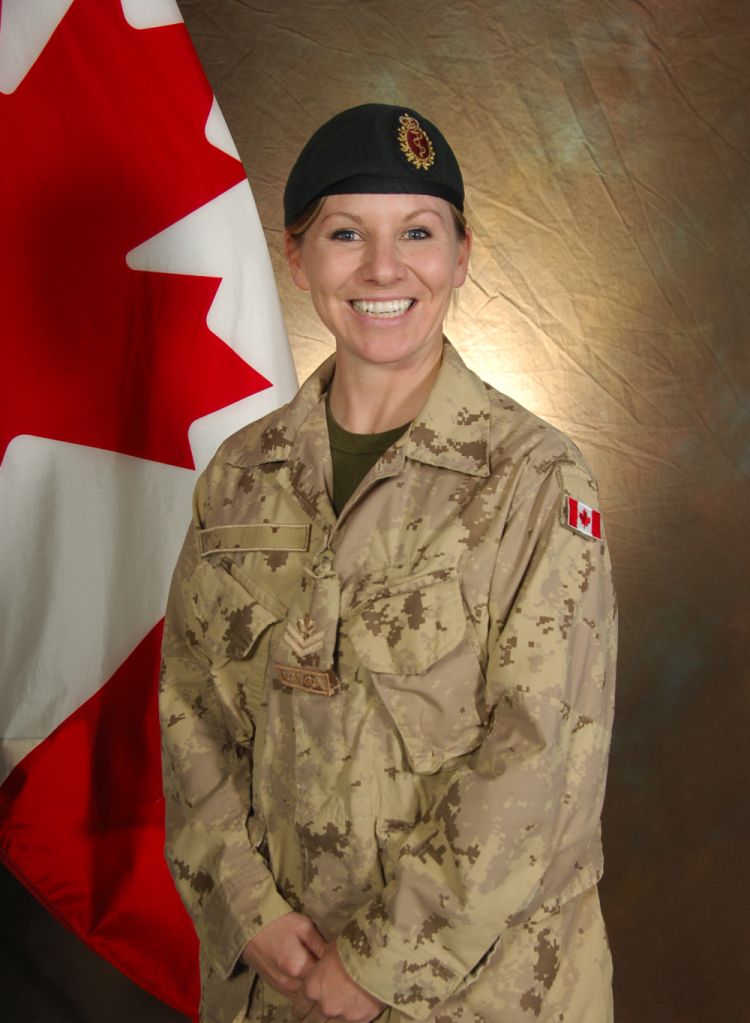WASHINGTON — In a pasture outside Dayton, Ohio, Wilbur and Orville Wright created the first practical airplane and taught themselves to fly it.
They called the place Huffman Prairie and flew the 1905 Wright Flyer III into history on that rough patch of land.
 |
| A section of MyBase islands in Second Life. Created and maintained by the Air Force. Courtesy of Pam Broviak Click to enlarge |
More than 100 years later, Air Force pioneers are creating a legacy in another place called Huffman Prairie, this one in a virtual world called “Second Life.” “What really drew us out to [the virtual world] was this wonderful opportunity to interact and connect with people on a global scale and with high levels of creativity,” Andrew Stricker of the Air Force’s Air University at Maxwell Air Force Base’s Gunter Annex in Montgomery, Ala., told American Forces Press Service.
“We thought Second Life was perfect for doing innovation work in the Department of Defense,” said Stricker, whose team is part of Air University’s innovations and integration division.
The online world — one of many now operating in cyberspace — was launched by San Francisco-based Linden Lab in 2003. Second Life has 20 million registered user accounts from all over the world and is populated by avatars, or digital representations that users create for themselves.
Second Life residents explore the world, meet other residents, socialize, participate in individual and group activities, and create and trade virtual property and services. All sorts of organizations, institutions and companies have established islands or activities in Second Life, including colleges and universities, libraries, government agencies, embassies, scientific research groups, religious organizations, and national defense ministries and departments, including the U.S. Defense Department and all of the services. Stricker and his team help to design, develop and implement new learning technologies and standards into Air Force and professional military education programs.
The Air Force is exploring several virtual worlds for its work in education and has several prototype virtual learning communities in Second Life. These include MyBase — a virtual Air Force base for recruiting, training, education and operations — and different versions of Huffman Prairie called Huffman Prairie Chi, Huffman Prairie Omega, and others. With MyBase, Air Force Maj. Gen. Erwin F. Lessel wanted an immersive experience that people could use to see what being in the Air Force is like, Stricker said.
At the time, Lessel — who retired in 2010 — was director of plans, programs, requirements and assessments for the Air Force. One of his responsibilities was developing and implementing future learning concepts.
“We created all these different roles that people can learn about as they travel through MyBase in Second Life — what it’s like to be a chaplain in the Air Force, what it’s like to be part of a medical team, to be in basic military training, to be a pilot.”
During a recent interview, Stricker joined Patrick “Mike” McCrocklin, chief of the innovations and integrations division in Air University’s education logistics and communications directorate, and Evelyn Milton, an information technology program analyst in the same division.
From MyBase, Milton said, avatars can “teleport or fly over to another region next to it and see a replication of a Navy area. The Naval Undersea Warfare Center out of Rhode Island is to the west of us in Second Life.”
To the north of MyBase are two Army sections, she said, one called OneSource, a virtual community that lets geographically dispersed soldiers, family members and friends stay in touch.
“Each region we have out there is dedicated to some particular area of learning,” McCrocklin said. “Huffman Prairie Gamma, for instance, is dedicated to educational informatics. MyBase Zeta is our gaming range.”
At MyBase Zeta, the Air Force built a training game called “Operation Relief Worker Rescue Challenge” to teach Air Force Academy cadets about leadership. “We got together with the Air Force Academy and the Center for Creative Leadership,” Stricker said, “and built a game where players had to go into the virtual world and rescue hostages who had been taken captive.”
During the challenge, the players operate in a specific scenario under a deadline and have to share information and work together. On the gaming range, avatars also freely interact with terrain, buildings, devices and equipment. The range has systems that can identify, track and score team members and follow voice and text communication among them.
There are briefing rooms, video recordings of game activity, target damage and scoring, simulated weather, day or night conditions, assignment of equipment and tools to each team member, and goal-oriented task action, timing and feedback controls for use by game referees.
Stricker said the leadership game was chosen as an example of interactions and innovations among people, organizations, processes and technology in the 2009 book, “Crosscutting Issues in International Transformation,” published by National Defense University.
In 2010, the Federal Virtual Worlds Challenge recognized another Air University project. The challenge is an annual, open, global call for the best virtual world implementations on a specific topic.
The Army Research Laboratory Simulation and Training Technology Center leads the effort, and in 2010 the topic was training, with categories for collaboration, skill building, instruction and visualization.
The $25,000 grand prize went to Stricker, McCrocklin and Cynthia Calongne of Air University for the Mars Expedition Strategy Challenge. Working with NASA’s Jet Propulsion Laboratory, Stricker said, “we basically took commission studies the White House sponsored on human space flight options for the future of the United States, and made a game out of it.”
In its recommendation, the commission had to weigh technology and cost issues, competitive stances for the country, political considerations and more. “In this game, you’re presented with the same kind of evidence the commission interacted with and you have to formulate your own position and articulate why you’ve taken it,” Stricker said.
“At the end of the game, you’re able to compare your recommendation to the commission’s,” he added, “and people tell us it’s a fun thing to do to see how close you’ve come.” Virtual worlds have the potential to transform education, Stricker said, by taking students on a journey that goes beyond reading words in a textbook. “As students must do in real life,” he said, in virtual-world learning situations “they have to develop skill sets to read the environment around them, collect data, interpret it, rationalize through understanding how to weigh the evidence, and then synthesize it and take a position.”
In Second Life and other virtual worlds, Stricker said, his team creates scenarios that allow students to manipulate pieces of a problem and see the consequences of their choices. “You have the students build a model of what they think they understand,” he said. “Say if you’re a meteorologist in the Air Force and you’re trying to understand the effects of certain geographic characteristics on weather flow patterns. Then you can manipulate the model and see the consequences.”
The team has built similar models for sustaining geothermal energy and, with the Air Force Institute of Technology, for understanding the effects of materials and atmospheric conditions on radar signals.
It’s like a revolution that’s occurring in what we can teach our students,” Stricker said. “Now students who may have had a hard time learning [from a book] can see a visualization. Our students are telling us that this is profound.” Virtual worlds are inherently collaborative, Stricker said, for students as well as for those who teach.
Multiple universities and agencies participate in every single Air Force virtual world project, he added. “We think a really exciting future is shaping up [in virtual words],” Stricker said, “where we’re breaking down walls across the services [and] finding common ground.” When Stricker and McCrocklin first discovered Second Life, they were drawn in by innovation occurring among people who collaborated across disciplines involving art, education and computer science, and across industry and government.
“We’re big believers in bringing people together who otherwise wouldn’t know the other groups exist,” Stricker said. Hetold a story about their early days in Second Life. One day at virtual Huffman Prairie, where they had built a 1920s airfield, he said, their avatars were testing an unmanned aerial vehicle.
“We were flying this thing around in front of our virtual hangars,” Stricker said, “and an avatar we’d never seen walks up and says, ‘Are you Dr. Stricker?’ Stricker, whose Second Life avatar is called Spinoza, was surprised, but said yes. The other avatar said, “Hold on, I’ll go get my dad.”
“Hi, I’m General Lessel,” the director of Air Force plans, programs, requirements and assessments said over his son’s Second Life voice chat. “I heard about you guys out here. I only have a few minutes, but tell me a little about what you’re doing.”
“For the next hour and a half, we walked him around and showed him stuff,” Stricker said. “From that experience, he flew out here … and sat down with Mike’s team.” Soon after, Sticker said, “he asked us to demonstrate what we could do with virtual worlds for the Air Force.”
“It matters a great deal that DOD is into [virtual worlds] right now,” Stricker said, “so we understand and can leverage and gain from our experiences how to go forward in the future.”
Source:
U.S. Department of Defense
Office of the Assistant Secretary of Defense (Public Affairs)

 von
von 